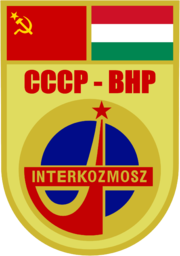
Back Soyuz-36 Azerbaijani Союз 36 Bulgarian Soiuz 36 Catalan Sojuz 36 Czech Sojus 36 German Σογιούζ 36 Greek Soyuz 36 Spanish سایوز ۳۶ Persian Sojuz 36 Finnish Soyouz 36 French
| COSPAR ID | 1980-041A |
|---|---|
| SATCAT no. | 11811 |
| Mission duration | 65 days, 20 hours, 54 minutes, 23 seconds |
| Spacecraft properties | |
| Spacecraft type | Soyuz 7K-T |
| Manufacturer | NPO Energia |
| Launch mass | 6,800 kilograms (15,000 lb) |
| Crew | |
| Crew size | 2 |
| Launching | Valeri Kubasov Bertalan Farkas |
| Landing | Viktor Gorbatko Pham Tuân |
| Callsign | Орион (Orion - "Orion") |
| Start of mission | |
| Launch date | 26 May 1980, 18:20:39 UTC |
| Rocket | Soyuz-U |
| Launch site | Baikonur 31/6 |
| End of mission | |
| Landing date | 31 July 1980, 15:15:02 UTC |
| Landing site | 140 kilometres (87 mi) SE of Dzhezkazgan |
| Orbital parameters | |
| Reference system | Geocentric |
| Regime | Low Earth |
| Perigee altitude | 197.5 kilometres (122.7 mi) |
| Apogee altitude | 281.9 kilometres (175.2 mi) |
| Inclination | 51.62 degrees |
| Period | 89.0 minutes |
| Docking with Salyut 6 | |
| Docking port | Aft port[1] |
| Docking date | May 27, 1980, 19:56 UTC[2] |
| Undocking date | July 04, 1980, 16:39 UTC[1] |
| Time docked | 37d 20h 43m |
| Redocking with Salyut 6 | |
| Redocking port | Front port |
| Redocking date | July 04, 1980, 17:09 UTC[1] |
| Unredocking date | July 31, 1980, 11:55 UTC[2] |
| Time redocked | 26d 18h 46m |

Soyuz programme (Crewed missions) | |
Soyuz 36 (Russian: Союз 36, Union 36) was a 1980 Soviet crewed space flight to the Salyut 6 space station. It was the 11th mission to and ninth successful docking at the orbiting facility. The Soyuz 36 crew were the first to visit the long-duration Soyuz 35 resident crew.[2]
Soyuz 36 carried Valery Kubasov and Bertalan Farkas, the first Hungarian cosmonaut, into space. They swapped Soyuz craft with the long-duration crew and returned to Earth in Soyuz 35; a later crew used their craft to return to Earth.
- ^ a b c Relocations of Manned Spacecraft
- ^ a b c The mission report is available here: http://www.spacefacts.de/mission/english/soyuz-36.htm